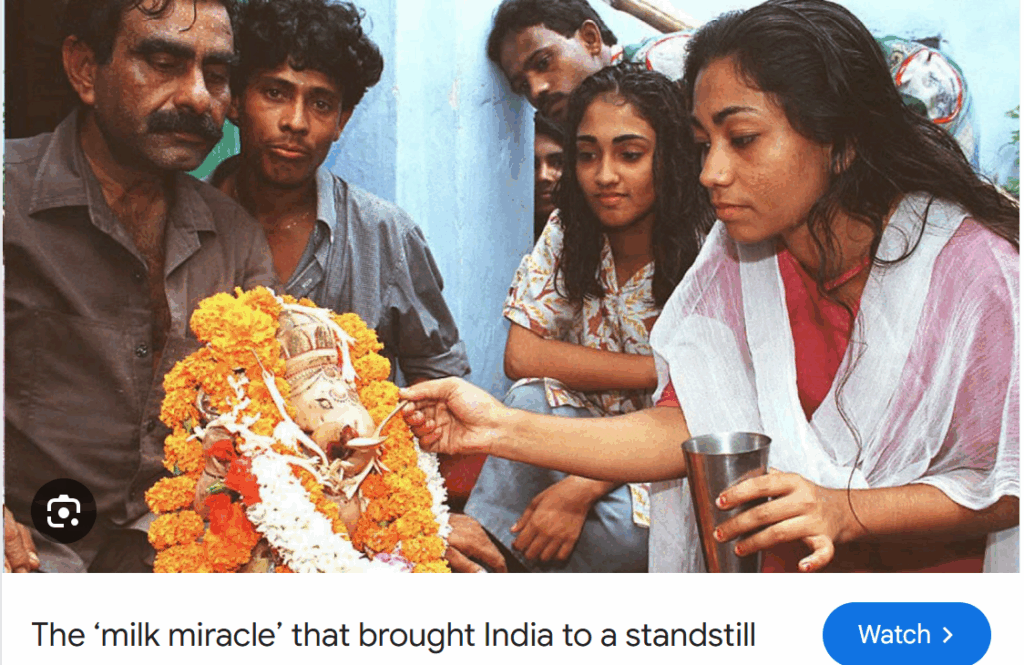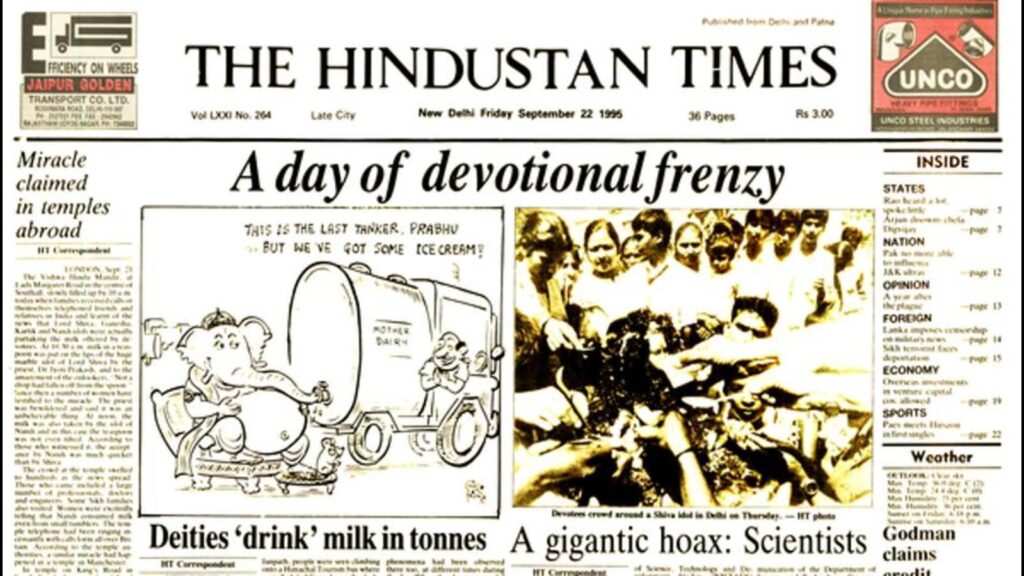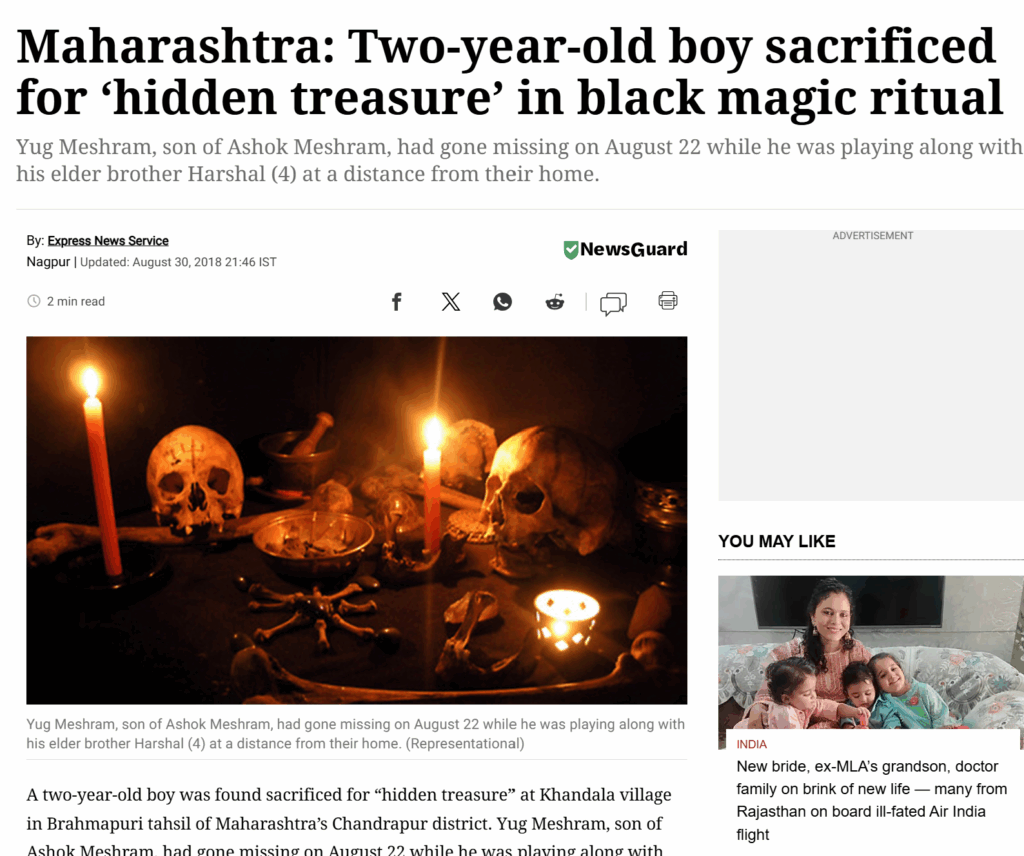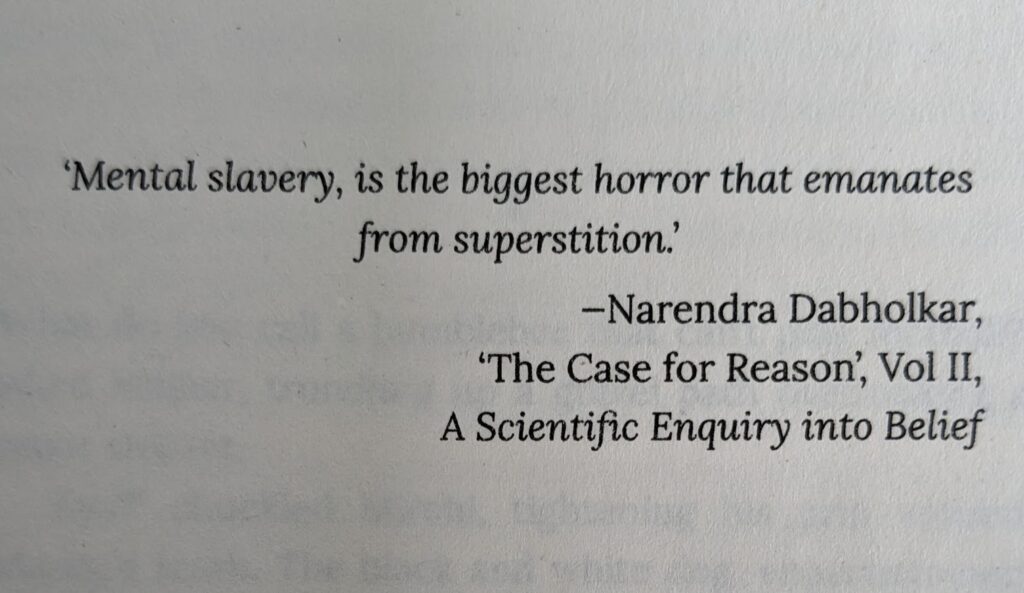In 1995, a rumour began to spread across India that Ganesha murtis were drinking milk.
Soon, people began holding spoons of milk before Ganpati tusks and watched in fascination as the milk vanished.

‘Lord Ganesha is drinking milk!’ the news caught on like wildfire – not just in India but across the world.
Thousands in Mumbai began flocking to temples carrying along milk to feed the deity. The Chief Minister of Maharashtra, Manohar Joshi, issued a statement saying it was indeed a miracle – he had seen Ganesha drink milk from his wife’s hand.
As they watched queues snaking out of temples, the Mumbai police began to get worried. Was this the start of an impending terrorist attack? Were people being lured into temples before some sort of ambush? Given the recent spate of terror the city had faced, they were tense and edgy.
Meanwhile, some in the media had joined the bandwagon, pouring copious litres of oil into the rising flames of irrationality.
Growing anxious, the Mumbai Police issued a red alert. The DCP of Mumbai had the good sense to approach a rationalist organisation (the Maharashtra Andhashradha Nirmoolan Samiti founded by Dr Narendra Dabholkar) to intervene and find out what was really going on.

When Mr Shyam Manav, a leader of the rationalist movement of Maharashtra began to investigate, he found plenty of evidence to show that the milk was only disappearing in idols made of mud or clay, and the milk absorbed by the murti, was getting accumulated at its base.
Stone and marble idols were not sucking up the milk. Nor was the milk getting sucked up from a glass. Only when a few drops were held in a spoon under a clay idol, was it disappearing. Clearly the only miracle here, was what is called capillary action – where surface tension caused the liquid to rise, especially along the curve of the idol’s trunk.
If you think about it, the phenomenon of capillary action is quite marvellous and worthy of wonder and awe. But that is another story for another day. Returning to the episode, when presented with the scientific explanation, the Police heaved a sigh of relief. And yet the DCP was worried about issuing a statement. Because none less than the Chief Minister himself had declared that it was a miracle.
That’s when Deputy Chief Minister Gopinath Munde stepped in to categorically dismiss all rumours about Ganpati idols drinking milk. The police then put up boards outside temples with the explanation. The mad frenzy finally stopped and the crowds melted away.

Tracing back, it had all begun when someone had claimed he had had a dream about Ganpati asking for milk. Often, dreams do not make sense at all; but an anecdotal irrational occurrence had turned into a dizzying spectacle of nation-wide stupidity. That too, back in 1995 when social media and 24-hour news channels did not exist to stoke the smallest of embers and turn them into raging infernos.
Nevertheless, then or now, the incident highlights the bedrock of the problem – the lack of scientific temper, made worse by politicians and celebrities jumping onto the miracle-bandwagon, instead of using their influence to call out the nonsense.
Full marks to the Mumbai Police for their alertness and their effort in 1995. But not everyone who is at the receiving end of society’s mindless irrationality, is so lucky.
When Fear becomes Fatal : How Superstition Kills
Just as conditions like diabetes are slow killers, and diseases like cancer take lives, so does irrationality. From little fears that prevent us from fulfilling our potential, and bigger taboos that hold us back from living freely, to vicious beliefs that completely destroy lives – superstition and irrationality are far more harmful than they seem.
According to the National Crime Records Bureau, more than 2000 women were killed in India following allegations of witchcraft between 2005 and 2015. These are cases where FIRs were registered. The actual figures are higher.
According to ASHA, a Ranchi based NGO working on the issue of witch-hunting, these numbers are not accurate. It estimates that about 1,00,000 women have been branded as witches in Jharkhand alone.

While superstition and lack of a scientific temper are undoubtedly key reasons for the existence of this shocking state of affairs in the modern era, in several cases, it was found that witch hunting was a way to deprive women of their land and property rights. Putting fear to effective use, the cloak of superstition is used as a weapon against gullible women to snatch land. Branding women as witches has been used as a method of dispossessing them of their property rights.
This precisely, is the theme of the Case of the Mysterious Witches, a book forming part of a series of Legal Mysteries for young readers, written by Mallika Ravikumar, and published by Speaking Tiger Books.

The Case of the Mysterious Witches : Brief Overview of the Plot
Fear of the mysterious has often led people to believe in outrageous ideas. When a set of random but unfortunate events take place in a tribal village near Maulsari, the blame is conveniently pinned upon a hapless widow named Mayawati who is branded a witch and hounded out of her home with her children.
The M4 (Meera, Malhar, Mirchi and Munna) who happen to be trekking out in the hills get sucked into this world, when they witness Mayawati being chased with stones and sticks, and nearly killed thereafter.
When they learn that villagers call her a daakin/daayan and accuse her of witchcraft, they are fearful but curious. Do witches really exist? Could these witches actually cure and curse with magic spells and potions?
As they dig deeper, they unravel an incredible nexus – an evil plot where blind faith and superstition are used as tools by the powerful to manipulate the vulnerable.
- A sorcerer baba who has turned spirituality into a business;
- A landlord whose pride is hurt that age-old caste hierarchies have been upturned;
- A close relative, drawn into the plot like a hapless pawn;
- A conservative society, conditioned to be forever reverent.
These factors make for a potent mix. When these powerful elements come together, women like Mayawati stand little chance. How do the M4 peel away layers of this intriguing puzzle to find out what really lays underneath? Will they manage to bring her justice?
The culture of baba-dom where fake holy-men lure people through superstitious beliefs is widespread in India. Mixed with a general lack of scientific temper amongst people, it has a disastrous effect on the lives of the vulnerable. Sample for instance, this piece of news from some years ago…

And if you think these ideas thrive only in rural or tribal areas, that couldn’t be further from the truth. A large section of urban and highly educated people throng to modern-day babas and matajis with belief in black magic, possession and a whole host of other irrational ideas.
The Case of the Mysterious Witches, has been written based on research into the various instances of witch-hunting in India, and attending workshops of of the Maharashtra Andh Shraddha Nirmoolan Samiti that has been doing stellar work in Maharashtra to fight the menace of blind faith and superstition.

The book nudges readers towards adopting the path of reason and rationality. It is available online and in bookstores.
This is the third book in the M4 Series of Legal Mysteries. Each book of the series seeks to shine light on an aspect of law and police procedure in India, through an exciting case solved by a group comprising three children and a dog. The other books in the series are
- The Case of the Vanishing Gods (a story about heritage theft, shortlisted for the Crossword Book Awards 2024)
- The Case of the Missing Turtles (a story about wildlife poaching)
The page on Critical Thinking on the author’s website has some additional material on the workshops of the Andh Shradha Nirmoolan Samiti, including exposing the tricks performed by babas and fake holy men.

